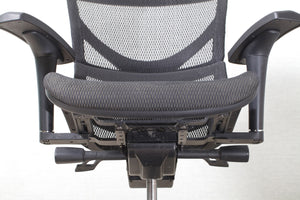Adjustability in office chair armrests is an essential feature that enhances ergonomic comfort. There are multiple axes along which armrests can be adjusted, depending on the chair's design:
-
Height Adjustment: This is the most common type of adjustability in armrests. The user can raise or lower the armrests to ensure that their arms are supported at a comfortable angle. Ideally, when typing or using a mouse, the user's arms should be at a 90-degree angle with the forearms parallel to the floor. Height-adjustable armrests are important in preventing shoulder and neck strain.
-
Width Adjustment: In some chairs, armrests can be moved closer together or further apart. This allows users of different body widths to position the armrests so that they comfortably support their forearms without needing to extend their elbows out to the sides or squeeze them too close together. This is especially useful for people with broader or narrower shoulders.
-
Depth Adjustment (Back and Forth): Some high-end office chairs allow armrests to slide backward or forward. This feature is useful as it lets users adjust the depth of the armrests based on the task they're doing, the length of their arms, or their sitting position. This can reduce strain on the wrists and shoulders when typing or resting.
-
Pivoting or Swivel Adjustment: Some armrests can be rotated or pivoted inwards and outwards. This can help support different tasks and can accommodate users' preference for arm positioning. For example, you might pivot the armrests inward when typing to better align your forearms with the keyboard.
-
Angle Adjustment: Few models of office chairs also offer an adjustment for the angle of the armrest, meaning you can tilt it to align with the natural angle of your resting arm.
To adjust these armrests, there is typically a button, lever, or dial located on or under the armrests that when engaged, allows the user to move the armrest up, down, in, out, forward, or backward. Once the lever is released or the button is disengaged, the armrests will lock into place at the new position.
When choosing a chair, the adjustability should be considered based on your specific needs, such as the type of work you do, the layout of your workspace, and your physical dimensions and preferences. These factors will determine the level of adjustability that is most beneficial to you.




































































































